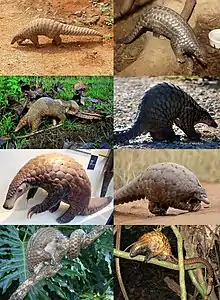Pholidotamorpha
Pholidotamorpha ("shape of pangolin") is a clade of mammals that includes the orders Palaeanodonta and Pholidota (the pangolins). In the past both orders were formerly classified with various other orders of ant-eating mammals, most notably Xenarthra, which includes the true anteaters, sloths, and the armadillos which pangolins superficially resemble. Newer genetic evidence, however, indicates their closest living relatives are the Carnivora with which they form the clade Ferae.[2][3] Some palaeontologists, placing Ernanodonta in a separate suborder of Cimolesta near Pholidota,[4] have classified the pangolins in the order Cimolesta, together with several extinct groups indicated (†) below, though this idea has fallen out of favor since it was determined that cimolestids were not placental mammals.[5] A 2012 study from new remains found in Late Paleocene Mongolian strata have led to the assessment that Ernanodon is closely related to Metacheiromys within the order Palaeanodonta, which, in the study, was reaffirmed to be the sister taxon of Pholidota.[6]
| Pholidotamorphs | |
|---|---|
 | |
| living pangolins | |
 | |
| Reconstruction of Ernanodon antelios | |
| Scientific classification | |
| Kingdom: | Animalia |
| Phylum: | Chordata |
| Class: | Mammalia |
| Clade: | Ferae |
| Clade: | Pholidotamorpha Gaudin et al., 2009 |
| Orders | |
Classification and phylogeny
Classification
- Clade: Pholidotamorpha
- Order: Pholidota (pangolins)
- Genus: †Euromanis
- Family: †Eurotamanduidae
- Suborder: Eupholidota (true pangolins)
- Order: †Palaeanodonta (stem-pangolins)
- Family: †Epoicotheriidae
- Family: †Escavadodontidae
- Family: †Metacheiromyidae (paraphyletic family)[6]
- Suborder: †Ernanodonta (pseudo-xenarthrans)
- Incertae sedis:
- Genus: †Amelotabes
- Genus: †Arcticanodon
- Genus: †Melaniella
- Order: Pholidota (pangolins)
Phylogeny
The phylogenetic relationships of clade Pholidotamorpha are shown in the following cladogram:[7][8][9][6][10][11][12]
| Ferae |
| ||||||||||||||||||||||||||||||||||||||||||||||||||||||||||||||||||||||||||||||||||
References
- Mark S Springer, Christopher A Emerling, John Gatesy, Jason Randall, Matthew A. Collin, Nikolai Hecker, Michael Hiller, Frédéric Delsuc (2019) Odontogenic ameloblast-associated (ODAM) is inactivated in toothless/enamelless placental mammals and toothed whales
- Murphy, Willian J., et al. (2001-12-14). "Resolution of the Early Placental Mammal Radiation Using Bayesian Phylogenetics". Science. 294 (5550): 2348–2351. Bibcode:2001Sci...294.2348M. doi:10.1126/science.1067179. PMID 11743200.
- Beck, Robin MD; Bininda-Emonds, Olaf RP; Cardillo, Marcel; Liu, Fu-Guo; Purvis, Andy (2006). "A higher-level MRP supertree of placental mammals". BMC Evolutionary Biology. 6 (1): 93. doi:10.1186/1471-2148-6-93. PMC 1654192. PMID 17101039.
- For example, McKenna & Bell 1997, p. 222 in which they included palaeanodonts. (Rose 2006, p. 210)
- Rook, D.L.; Hunter, J.P. (2013). "Rooting Around the Eutherian Family Tree: the Origin and Relations of the Taeniodonta". Journal of Mammalian Evolution. 21: 1–17. doi:10.1007/s10914-013-9230-9.
- Kondrashov, Peter; Agadjanian, Alexandre K. (2012). "A nearly complete skeleton of Ernanodon (Mammalia, Palaeanodonta) from Mongolia: morphofunctional analysis". Journal of Vertebrate Paleontology. 32 (5): 983–1001. doi:10.1080/02724634.2012.694319. ISSN 0272-4634.
- Amrine-madsen, H.; Koepfli, K.P.; Wayne, R.K.; Springer, M.S. (2003). "A new phylogenetic marker, apolipoprotein B, provides compelling evidence for eutherian relationships". Molecular Phylogenetics and Evolution. 28 (2): 225–240. doi:10.1016/S1055-7903(03)00118-0. PMID 12878460.
- Kenneth D. Rose (2008). "9 - Palaeanodonta and Pholidota". doi:10.1017/CBO9780511541438.010. Cite journal requires
|journal=(help) - Gaudin, Timothy (2009). "The Phylogeny of Living and Extinct Pangolins (Mammalia, Pholidota) and Associated Taxa: A Morphology Based Analysis" (PDF). Journal of Mammalian Evolution. Heidelberg, Germany: Springer Science+Business Media. 16 (4): 235–305. doi:10.1007/s10914-009-9119-9.
- Halliday, Thomas J. D.; Upchurch, Paul; Goswami, Anjali (2015). "Resolving the relationships of Paleocene placental mammals" (PDF). Biological Reviews. 92 (1): 521–550. doi:10.1111/brv.12242. ISSN 1464-7931. PMID 28075073.
- Solé, F. & Ladevèze, S. (2017). "Evolution of the hypercarnivorous dentition in mammals (Metatheria, Eutheria) and its bearing on the development of tribosphenic molars." Evolution & Development, 19(2), 56–68.
- Prevosti, F. J., & Forasiepi, A. M. (2018). "Introduction. Evolution of South American Mammalian Predators During the Cenozoic: Paleobiogeographic and Paleoenvironmental Contingencies"